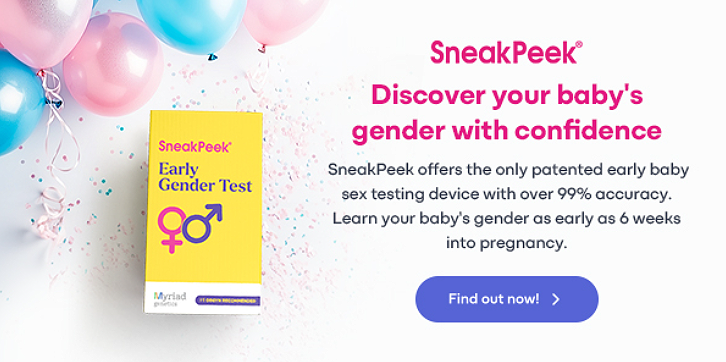Published on March 23rd, 2023 and Updated on January 13th, 2025
Check out SneakPeek Gender Test to find out your baby’s gender as early as 6 weeks with over 99% accuracy!

Each month, numerous women experience abdominal discomfort. However, when you’re actively trying to get pregnant, these cramps might not be the usual menstrual pains; they could be signs of pregnancy.
Stomach cramps can be one of many common menstruation symptoms or early pregnancy symptoms, much like discharge before a period vs early pregnancy. While they may feel similar, there are some distinct differences between these two types of cramps—some which may help you identify whether you’re expecting or not.
In this blog, we’ll unknot the topic of period cramps vs. early pregnancy cramps, including their sensations, causes, and symptoms.
Understanding Period Cramps: Causes, Sensations, and Associated Symptoms
If you menstruate, you’ve likely had dysmenorrhea—a.k.a., period cramps. In fact, about 4 out of 5 women experience period pain at some point during their menstrual years.
Everyone’s period cramps may feel slightly different, from minor stomach pangs to day-stopping back aches. However, there are a few similarities that differentiate period cramps from those related to pregnancy symptoms.
What are period cramps?
Each month, your body prepares for potential pregnancy by building up the uterine lining—a combination of tissue and blood. If fertilization doesn’t occur, the uterus sheds its lining to start a new cycle. To aid this process, the body releases prostaglandin, which causes uterine contractions, leading to cramps.
The menstrual cycle spans 21 to 35 days, and consists of four reproductive phases dictated by rising and falling hormones:
- Menstruation (Days 1 to 7) – The first day of your menstrual cycle kicks off your period, triggered by a sudden drop in progesterone and estrogen. This phase is the most likely to come with cramps because when your uterus contracts to shed its lining, its blood vessels are compressed. This causes your uterus’ blood and oxygen supply to be cut off temporarily, resulting in the release of pain-triggering chemicals.
- Follicular phase (Days 7 to 14) – Once your period ends, the hormones estrogen and follicle-stimulating hormone (FSH) start to rise. This stimulates the growth of a new egg in the ovaries.
- Ovulation (Days 10 to 14) – Once your estrogen and luteinizing hormone (LH) levels peak, a mature egg is released out of an ovary (a process known as ovulation). Some women may experience ovulation pain (or light cramps) during this phase. Since these light cramps are caused by the release of an egg from one of your ovaries, this pain will usually only occur on one side of the lower abdomen.
- Luteal (Days 15 to 28) – Once an egg is released, the empty egg follicle (now called a corpus luteum) emits progesterone, which tells your body to build up the uterine lining. If no fertilized egg implants, your high levels of estrogen and progesterone suddenly fall. This may trigger uterine cramps and will eventually kick off the next menstrual phase.
What do period cramps feel like?
“Cramping” is a vague term. Does it mean a twist? A punch? A pull? A tightening? In the case of period cramps, it can be all of the above—and then some.
Period cramps are no one-size-fits-all scenario. For some women, period cramps feel like light gas. For others, period cramps are much more painful, and can make it hard to complete everyday tasks. While period cramps may feel different from cycle to cycle, most women will have similar period cramps across their life. Alongside these cramps, most women will also bleed anywhere from 2 to 7 days during their period.
So, why do some women suffer a little more around the red wave? Unfortunately, there’s no easy answer. The severity of your period cramps can depend on a number of health factors, such as:
- Genetics
- Hormonal imbalances
- Medical conditions (like pelvic inflammatory disorder or endometriosis)
- Intrauterine devices (IUDs)
What other symptoms come with period cramps?
When deciphering between period and pregnancy cramps, one of your strongest guides is your body—i.e., the other symptoms that come with the cramps.
Many women experience additional symptoms around their premenstrual week and period. In fact, up to 95% of women experience PMS symptoms, with 5% having debilitating symptoms that interfere with their quality of life. Besides cramping, these symptoms may include:
-
- Abdominal bloating
- Non-abdominal pain (lower back, pelvis, etc.)
- Breast tenderness
- Fatigue
- Constipation
- Headaches
- Mood changes (depression, irritability, anxiety, etc.)
- Fatigue
- Acne
Implantation or Pregnancy Cramps: Causes, Sensations, and Associated Symptoms
If you’re trying to get pregnant, any sign of mild cramping may strike disappointment or fear—but don’t panic. Mild cramps, and even light bleeding, could be a sign that you’re right on track towards the stages of prenatal development. Let’s explore the types, causes, and symptoms of early pregnancy cramps.
What are early pregnancy cramps?
During the first trimester (weeks 0 to 13), women may experience cramping for a few reasons. While some cramps may be directly related to a growing baby, others may hint at a pregnancy-related health condition that requires serious attention.
A few causes of early pregnancy cramps include:
- Implantation bleeding – When someone says “early pregnancy cramp”, they usually mean implantation cramps. For a successful pregnancy, a fertilized egg must implant (or latch) onto your uterine wall. This action can create mild abdominal cramps and light vaginal bleeding—usually nothing more than 1 to 2 days of spotting. Up to 20% of pregnant women experience implantation bleeding.
- Ectopic pregnancy – In North America, nearly 2% of pregnancies become an ectopic pregnancy. This condition occurs when a fertilized egg implants outside of the uterus, creating a very dangerous (and possibly fatal) situation for the mother. Most ectopic pregnancies develop symptoms around weeks 6 to 8, such as severe vaginal bleeding, one-sided cramping, dizziness, or shoulder pain.
- Miscarriage – The majority of miscarriages happen before the 12th week of pregnancy. Up to 20% of pregnancies end in miscarriage, often bringing symptoms like vaginal bleeding and cramps in the abdomen or lower back.
What does implantation cramping feel like?
Just like PMS cramps, early pregnancy cramps can range from mild to debilitating—it all depends on the cause of your cramps.
For most women, early pregnancy cramps are usually caused by implantation. These cramps tend to be milder and shorter overall, with qualities like:
- Minor abdominal pain
- Prickling or tingling sensations
- Light spotting or bleeding with pink or light brown blood
- Thin and watery discharge
Just remember—if you experience severe cramping or bleeding that’s abnormal to your period, you should contact your doctor immediately. The more severe the cramps, the more likely they may signal dangerous conditions, like an ectopic pregnancy or miscarriage.
What other symptoms come with early pregnancy cramps?
Most women don’t escape early pregnancy without experiencing a few physical changes. While these symptoms may be bothersome (hello, morning sickness!), they can also work as signals that you might be expecting.
Beyond implantation cramps, about 88% of women experience at least two pregnancy-related symptoms during the first trimester, such as:
-
- Nausea
- Vomiting
- Vulvar itching
- Vaginal bleeding
- Breast tenderness
- Fatigue
- Dizziness
- Food cravings or aversions
- Moodiness
- Changes to the nipples or areolas
How to Differentiate Period Cramps vs. Implantation Cramps
Do you need a pregnancy test to tell if your cramps mean you’re having your period or you might be pregnant? To know for sure, yes you do. However, you can still make an educated guess by evaluating the main differences between these two types of cramps:
-
- Location: Early pregnancy cramps stay around the lower abdomen, while period cramps can spread into the pelvic area, lower back, or thighs.
- Timing: Period cramps always happen a few days before and during menstruation. Implantation cramps occur shortly after ovulation, just before your expected period. Cramps from an ectopic pregnancy or miscarriage can happen well into the first trimester.
- Duration: Some women have short-lived period cramps, similar to implantation cramps. However, the duration of your bleeding can help tell them apart. Period-related cramps typically last during the 2 to 7 days of bleeding, while pregnancy-related cramps may accompany 1 to 2 days of bleeding. If your bleeding goes beyond 7 days, it may be related to other health conditions.
- Other symptoms: Consider your other symptoms. Periods often come with headaches, fatigue, and bloating, while signs of early pregnancy can bring symptoms like nausea, vomiting, and tender breasts.
Coping with Cramps
Dealing with abdominal cramps, whether due to your menstrual cycle or early pregnancy, can be uncomfortable. Fortunately, there are various strategies and remedies that can help alleviate the discomfort:
-
- Over-the-Counter Pain Relievers: Non-prescription pain relievers like ibuprofen or acetaminophen can relieve cramps. Consult with a healthcare provider if you have any concerns or medical conditions.
- Heat Therapy: Applying heat to your lower abdomen can relax tense muscles and ease cramps. Try using a heating pad or taking a warm bath to relieve discomfort.
- Gentle Exercises and Stretches: Light physical activity, such as walking or gentle yoga, can help improve blood circulation and reduce cramping.
- Relaxation Techniques: Stress and anxiety can exacerbate cramps. Try relaxation techniques like deep breathing exercises, and meditation to calm your body and mind.
- Herbal Remedies: Some herbal teas and supplements, such as chamomile or ginger tea, are believed to have anti-inflammatory properties and may help relieve cramps. Consult a healthcare provider before using herbal remedies, especially if you’re pregnant.
- Dietary Changes: Certain dietary adjustments can potentially reduce cramping. Avoiding excessive caffeine, salty foods, and sugary snacks may help manage bloating and discomfort. Staying hydrated is also crucial.
When to Seek Medical Attention
While understanding the differences between period cramps and early pregnancy cramps can be helpful, certain symptoms warrant immediate medical attention. If you experience any of the following, contact your healthcare provider promptly:
-
- Severe abdominal pain, especially if it’s one-sided or persistent
- Heavy vaginal bleeding that surpasses your regular menstrual flow
- Dizziness or fainting
- Shoulder pain
- Any unusual or concerning symptoms that raise doubts about your health or pregnancy status
When to Take a Pregnancy Test
It’s common for individuals to consider taking a pregnancy test as soon as they suspect pregnancy or after they’ve missed a period. Certain at-home pregnancy tests advertise the ability to detect pregnancy up to five days before your anticipated period. Nevertheless, healthcare experts usually recommend caution when testing too early, as it can occasionally lead to unreliable results. Instead, it’s often considered safer to aim for the first day of your missed period.You may be wondering can an ovulation test detect pregnancy? This is not the case, so be sure to purchase the right kind of at-home test.
Takeaways
Abdominal cramps, whether experienced during your period or early pregnancy, can feel alike, but certain signs can help you distinguish between them. Light spotting may accompany both types of cramps. While it can be challenging to tell them apart, early pregnancy cramps are generally described as less severe than period cramps. To confirm, it’s advisable to take a pregnancy test as soon as your period is missed or consult a healthcare provider for confirmation.
Navigate Early Pregnancy with SneakPeek
Whether they signal a period or a potential pregnancy, cramps are never a pleasant experience. However, when it comes to early pregnancy cramping, it might just be a hopeful sign of the journey ahead—welcoming your little one.
Pregnancy and parenthood are filled with questions – can you get pregnant if you pee after sex? Can you drink sparkling water while pregnant? Our blog has the information you need. And once you feel ready? SneakPeek is here to answer more of your questions.
At just 6 weeks pregnant, the SneakPeek At-Home Early Gender Blood Test can reveal whether a little boy or girl is heading your way. Our #1 OB-GYN recommended at-home test delivers over 99% clinically-accurate1 results with full data protection, so you can feel safe and secure while learning more about your little one. Just send in your sample, and we’ll take care of the rest.
When you’re ready to meet your little one, bridge the gap between mama and belly by joining the 1 million parents who trust SneakPeek Test.
Editorial Policy
At SneakPeek, our commitment is to provide accurate, up-to-date, and reliable information to empower our readers. Our content is thoroughly researched, reviewed by medical experts, and fact-checked to ensure its credibility. We prioritize the well-being and education of our readers, and our editorial policy adheres to the highest standards of integrity and accuracy in all our articles.
Editorial Policy
At SneakPeek, our commitment is to provide accurate, up-to-date, and reliable information to empower our readers. Our content is thoroughly researched, reviewed by medical experts, and fact-checked to ensure its credibility. We prioritize the well-being and education of our readers, and our editorial policy adheres to the highest standards of integrity and accuracy in all our articles.
This post has been reviewed for accuracy by the following medical professionals:
Dr. Heather Soper, Certified Nurse Midwife
Dr. Heather Soper brings over 15 years of experience in women's health and obstetrics to her role as the owner of The Genesis Resort for Birth. Complementing her clinical practice, she serves as an Assistant Professor of Nursing at James Madison University, where she educates nursing students with a focus on compassionate, patient-centered care. Her advanced training and dedication to midwifery are evident in her contribution to both academia and the wellness of expectant mothers
Katie Smith is a seasoned Certified Nurse Midwife and a nurturing mother to six children, offering a unique blend of professional expertise and personal experience. She is the founder of Birth Your Way Midwifery and Women’s Wellness Center in Bay County, Florida. Katie's comprehensive approach to care is informed by her hands-on experience in motherhood and her passion for empowering women through their birthing journey. Her dedication extends beyond her center as she actively engages in community wellness and family health education.
Sources:
- AAFP. Ectopic Pregnancy. https://www.aafp.org/pubs/afp/issues/2000/0215/p1080.html.
- BMC Pregnancy and Childbirth. Development and validation of a pregnancy symptoms inventory. https://bmcpregnancychildbirth.biomedcentral.com/articles/10.1186/1471-2393-13-3
- Cleveland Clinic. Menstrual Cycle (Normal Menstruation): Overview & Phases. https://my.clevelandclinic.org/health/articles/10132-menstrual-cycle
- Forbes. Implantation Bleeding: An Early Sign Of Pregnancy. https://www.forbes.com/health/family/what-is-implantation-bleeding/
- Mayo Clinic. Ectopic pregnancy. https://www.mayoclinic.org/diseases-conditions/ectopic-pregnancy/symptoms-causes/syc-20372088
- Mayo Clinic. Menstrual cramps – Symptoms and causes. https://www.mayoclinic.org/diseases-conditions/menstrual-cramps/symptoms-causes/syc-20374938
- Mayo clinic. Miscarriage. https://www.mayoclinic.org/diseases-conditions/pregnancy-loss-miscarriage/symptoms-causes/syc-20354298
- MedlinePlus. Menstruation | Period. https://medlineplus.gov/menstruation.html
- NHS. Ovulation pain. https://www.nhs.uk/conditions/ovulation-pain/.
- NHS. Periods and fertility in the menstrual cycle. https://www.nhs.uk/conditions/periods/fertility-in-the-menstrual-cycle/
- NHS. Period pain. https://www.nhs.uk/conditions/period-pain/
- NIH. Examining to what extent pregnancy-related physical symptoms worry women in the first trimester of pregnancy: a cross-sectional study in general practice. https://www.ncbi.nlm.nih.gov/pmc/articles/PMC6995862/
- NIH. Premenstrual syndrome. https://www.ncbi.nlm.nih.gov/pmc/articles/PMC4548199/
- Parents Magazine. Cramps During Pregnancy: What They Mean and When to Call a Doctor. https://www.parents.com/pregnancy/my-body/aches-pains/cramping-during-pregnancy/
- Verywell Health. How Do Period vs. Early Pregnancy Cramps Feel? https://www.verywellhealth.com/period-cramps-vs-early-pregnancy-cramps-7097107
- Women’s Health Concern. Period pain. https://www.womens-health-concern.org/wp-content/uploads/2022/12/20-WHC-FACTSHEET-Period-Pain-NOV2022-B.pdf
- NHS. Period pain. https://www.nhs.uk/conditions/period-pain/
- Planned Parenthood. Pregnancy Tests https://www.plannedparenthood.org/learn/pregnancy/pregnancy-tests









